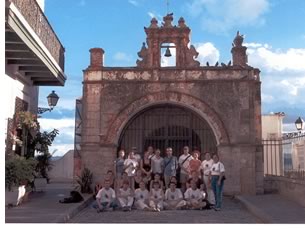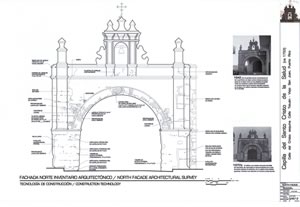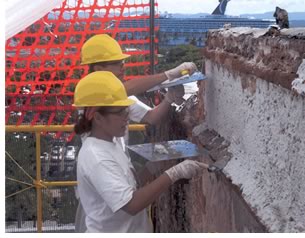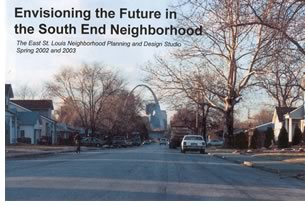

Teaching Faculty Members Win Accolades for Innovative Courses
 The
AIA has announced the recipients of the 2004 AIA Education Honor Awards
for excellence in course development and architecture teaching. The program,
now in its 15th year, honored recipients March 19 at the Association of
Collegiate Schools of Architecture annual meeting in Miami. The awards
jury included Chair Ron McCoy, AIA, director, Arizona State University
School of Architecture; Thomas R. Mathison, AIA, Michigan AIA regional
director; James W. Ritter, FAIA, Washington Alexandria Architecture Center;
and Katherine Bojsza, Assoc. AIA, vice president, American Institute of
Architecture Students.
The
AIA has announced the recipients of the 2004 AIA Education Honor Awards
for excellence in course development and architecture teaching. The program,
now in its 15th year, honored recipients March 19 at the Association of
Collegiate Schools of Architecture annual meeting in Miami. The awards
jury included Chair Ron McCoy, AIA, director, Arizona State University
School of Architecture; Thomas R. Mathison, AIA, Michigan AIA regional
director; James W. Ritter, FAIA, Washington Alexandria Architecture Center;
and Katherine Bojsza, Assoc. AIA, vice president, American Institute of
Architecture Students.
The jury noticed interesting trends among the group of submissions. “We see greater attention being given to addressing complex social issues through multidiscipline design and engagement with communities, neighborhoods, and planning agencies,” Mathison says. “This is an important sign that architecture students continue to explore key societal linkages in their training to be leaders of change through design, creative problem solving, and civic volunteerism.”
 This
year’s honor award winners are:
This
year’s honor award winners are:
“Preservation Praxis,” by the Polytechnic University of Puerto Rico New School of Architecture and University of Pennsylvania Graduate Program in Historic Preservation. The schools offer this advanced technology elective jointly to architecture undergraduates from the Caribbean and graduate students in historic preservation from U.S. universities. The class allows for representatives from two disciplines to embrace the documentation, analysis, and treatment of historic sites through extensive archival, laboratory, and site visits.
 Focusing
on conservation issues pertaining to specific architectural icons, students
learn to apply the knowledge and skills required for interpretation and
intervention of high-profile historic structures. Projects cover the full
spectrum of conservation, including historic research, building documentation,
sampling of materials, scientific analysis, and production of technical
drawing and specifications.
Focusing
on conservation issues pertaining to specific architectural icons, students
learn to apply the knowledge and skills required for interpretation and
intervention of high-profile historic structures. Projects cover the full
spectrum of conservation, including historic research, building documentation,
sampling of materials, scientific analysis, and production of technical
drawing and specifications.
Students make the often highly technical studies understandable to the public through presentations to children, young adults, government officials, and construction industry professionals. “Preservation Praxis presented a sophisticated model of the highly specialized knowledge of historic preservation,” McCoy says. “The jury was impressed with the depth of the exploration and the integration of material science, design, history, and archaeology.”
 “Envisioning
the Future in the South End Neighborhood,” by the University of
Illinois at Urbana-Champaign School of Architecture. This studio-based
urban-design and planning process course supports the ongoing community
development efforts of the South End New Development Organization (SENDO).
It reflects the evolution of a 13-year program of outreach, providing
technical assistance to the neighborhood-based organizations in East St.
Louis, Ill. For years, no existing city-level agency offered the requisite
design, planning, or community development support for nonprofit organizations.
This service-learning course with students and faculty from the school
of architecture and the departments of landscape architecture and urban
and regional planning took on the needs of that area of the city through
the curriculum. The course aims to facilitate a preparatory planning and
urban design process in the South End neighborhood and, through this process,
to teach students about community-based planning and design.
“Envisioning
the Future in the South End Neighborhood,” by the University of
Illinois at Urbana-Champaign School of Architecture. This studio-based
urban-design and planning process course supports the ongoing community
development efforts of the South End New Development Organization (SENDO).
It reflects the evolution of a 13-year program of outreach, providing
technical assistance to the neighborhood-based organizations in East St.
Louis, Ill. For years, no existing city-level agency offered the requisite
design, planning, or community development support for nonprofit organizations.
This service-learning course with students and faculty from the school
of architecture and the departments of landscape architecture and urban
and regional planning took on the needs of that area of the city through
the curriculum. The course aims to facilitate a preparatory planning and
urban design process in the South End neighborhood and, through this process,
to teach students about community-based planning and design.
 The
students provided community groups with deliverables that include a comprehensive
physical conditions assessment, community design and planning guidelines,
site-specific proposals to achieve neighborhood growth goals, and a feasible
implementation strategy. “This class represents excellence in community
process and socially engaged urban design. The jury recognized this to
be an area of inquiry that has been under way within schools since the
1960s, and an area of study that has become more dominant and sophisticated
in the last 10 years,” McCoy says. “This submission was recognized
as exemplary of a multidisciplinary community design class.”
The
students provided community groups with deliverables that include a comprehensive
physical conditions assessment, community design and planning guidelines,
site-specific proposals to achieve neighborhood growth goals, and a feasible
implementation strategy. “This class represents excellence in community
process and socially engaged urban design. The jury recognized this to
be an area of inquiry that has been under way within schools since the
1960s, and an area of study that has become more dominant and sophisticated
in the last 10 years,” McCoy says. “This submission was recognized
as exemplary of a multidisciplinary community design class.”
The jury also elected to give honorable mentions to “Lessons From Practice,” a course taught by Kevin Mitchell at the American University of Sharjah, United Arab Emirates, and “Color Theory/Electronic Color,” a course taught by Glenn Goldman, AIA, New Jersey Institute of Technology School of Architecture.
Copyright 2004 The American Institute of Architects.
All rights reserved. Home Page ![]()
![]()
